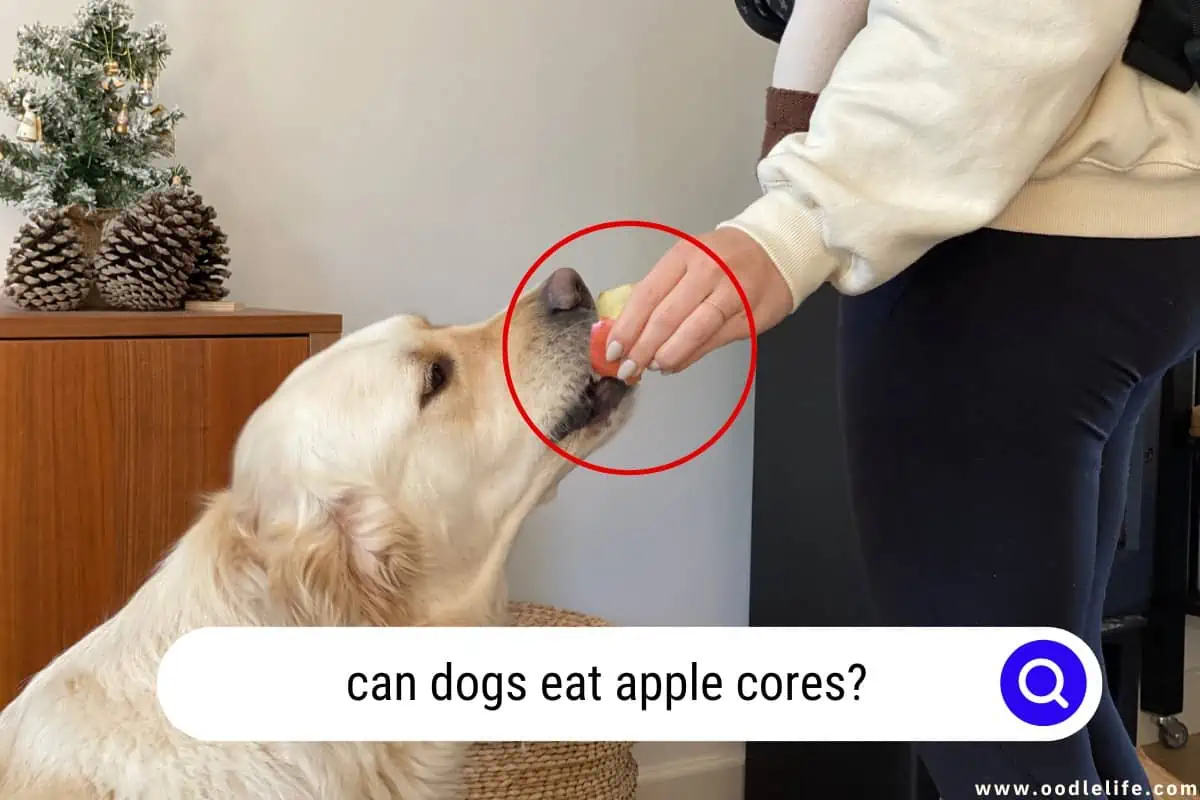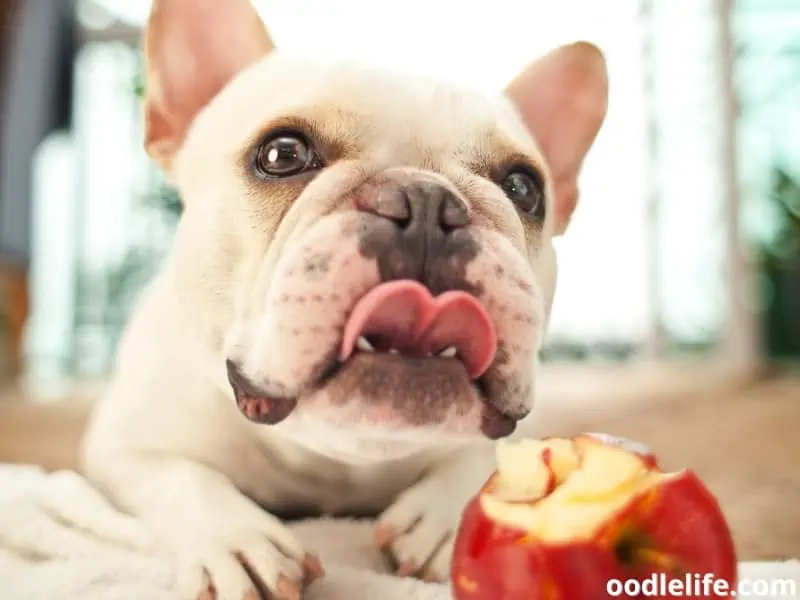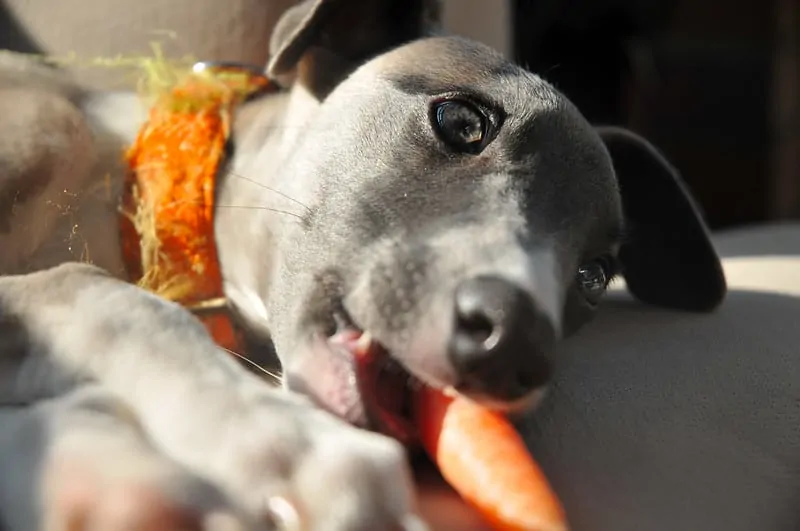Can Dogs Eat Apple Cores? (Danger!)
An apple a day may keep the doctor away for us humans, but what about our furry friends? As a dog lover, you might wonder if sharing a crunchy apple core with your canine companion is a healthy treat or a hidden hazard.
While apples themselves are a nutritious snack for dogs, apple cores, specifically, should be avoided.

They contain seeds that can be harmful to your pet, as they contain a substance called cyanide. It’s best to remove the core and seeds, giving your dog the delicious, vitamin-rich flesh of the apple instead.
Read on to discover more about the safe ways to share apples with your four-legged friend!
Apples as a Dog Snack (Yep!)
Dogs can definitely enjoy apples as a healthy treat! Apples are a great source of vitamins A, C, calcium, and fiber, as well as antioxidants and potassium. These nutrients can provide numerous benefits for your furry friend.
However, it’s important to serve apples in moderation and in a sensible amount to avoid any digestive issues.
Apple Appropriateness for Dogs
| Apple Product | Appropriate for Dogs? | Notes |
|---|---|---|
| Fresh Apple (no core) | Yes | Remove core and seeds; wash thoroughly |
| Apple Core | No | Seeds contain cyanide; can be a choking hazard |
| Apple Sauce | Yes (in moderation) | Avoid added sugar and spices |
| Apple Juice | No | Sugar content is too high for dogs |
| Apple Pie | No | High sugar and fat; may contain spices |
| Apple Seeds | No | Contain cyanide; harmful in large quantities |
Remember, when considering an apple product for your dog, it’s essential to pay attention to the ingredients and serve in moderation. Always consult with a veterinarian if you have any doubts!
Adding apples to your dog’s diet can be a fun and low-calorie alternative to traditional treats. Just like humans, dogs love the sweet and crunchy texture of apples. When introducing apples to your dog’s diet, consider starting with applesauce or small, bite-sized pieces of apple. This makes it easier for your dog, especially puppies, to enjoy apples without any choking hazards.
Feeding your pup apples as treats can be a rewarding experience for both of you. Imagine enjoying a crisp apple, and sharing a few slices with your four-legged companion. It’s a great bonding moment, and you can feel good about providing your dog with healthy and nutritious treats.
However, remember that everything should be served in moderation. While apples provide valuable nutrients for dogs, they should not replace their regular meals. Balance is key, so try giving apples as occasional treats alongside other vegetables and fruits that are safe for dogs.
In conclusion, apples can make tasty, low-calorie treats for dogs, when served in a sensible amount and with some precautions in mind. Just picture yourself and your furry friend munching on apples together, and enjoy the benefits of providing your dog with a healthy and delicious treat.
Choking and Health Hazards
Ah, the apple core conundrum: To share or not to share with our canine companions? Let’s dive into potential hazards that could turn this fruity treat into a not-so-sweet experience for your pet pooch.

First off, let’s address that pesky choking hazard. It’s not every day that an apple core poses severe jeopardy to your dog, but the risk is there. The core’s size, hardness, and shape can, unfortunately, lead to choking, especially for smaller dogs. So, it’s not exactly the ideal chew toy.
Next up, the seeds. Apple seeds contain a compound called amygdalin, which releases cyanide when chewed or digested. Now, don’t go into panic mode; your dog would need to consume a considerable amount of seeds (and break them open) to pose a real threat. While it might not be cyanide central, it’s still better to err on the side of caution and keep those seeds away from your furball.
On the topic of unwanted guests, bacteria can hitch a ride on apple cores, particularly if they’ve been left sitting for a while. Ever heard of the expression, “An apple a day keeps the doctor away?” Well, that rule doesn’t apply to old, bacteria-laden cores for your pup.
Now, here’s the real buzzkill: pesticides. Apples can sometimes be coated in chemicals to keep pesky bugs at bay. While these pesticides are generally not harmful to humans, they might be too strong for your dog’s gut to handle. So, a simple rinse under the tap might not be enough to decontaminate that core.
In conclusion, while apples themselves can be a nice treat for your dog (minus the core), it’s always better to play it safe. Chances are, Fido won’t be missing out on any vital nutrients by skipping the occasional apple core. In fact, they’ll probably thank you for not sharing this one time.
Toxicity of Apple Cores and Seeds
Apple cores and seeds contain a natural compound called amygdalin, which can release cyanide once consumed and metabolized by the body. It’s important to understand the potential risks of apple cores and seeds for dogs, as the toxic nature of cyanide can pose a threat.

Symptoms of Cyanide Poisoning
If your dog consumes a significant amount of apple seeds, they may experience symptoms of cyanide poisoning. Some signs to watch out for are:
- Difficulty breathing
- Dilated pupils
- Excessive salivation
- Dizziness or disorientation
- Rapid heart rate
- Vomiting
- Collapse or seizures
In severe cases, cyanide poisoning can even be fatal for your furry friend.
ASPCA Poison Control
If you suspect your dog has consumed a potentially dangerous amount of apple seeds or cores, it’s crucial to act quickly. The ASPCA Poison Control has a 24-hour hotline number you can reach for advice: 1-888-426-4435. Call them to help identify the best course of action for your dog’s safety.
Now that you know about the toxicity of apple cores and seeds, remember that sharing an apple with your dog can still be a healthy treat! Just make sure to remove the core and seeds before giving it to them. Better safe than sorry, and watching your dog enjoy a juicy slice without any worry brings joy to both of you.
Digestive Issues and Allergic Reactions
Now, let’s talk about digestive issues and allergic reactions when it comes to feeding apple cores to our beloved furry friends. It’s important to be in the know and keep our pets happy and healthy!

First off, much like humans, dogs can also experience allergic reactions. While these cases are quite rare, it’s crucial to look out for any strange behaviors after your dog has consumed an apple core. Keep an eye on signs like itching, swelling, and breathing difficulty. If you notice any of these symptoms or suspect an allergy, contact your vet as soon as possible.
Moving on to potential digestive issues, apples are a good natural source of fiber. Fiber can be beneficial for your dog’s digestion, aiding in bowel movements and overall gut health. However, too much of a good thing can also cause trouble. Consuming large amounts of apple cores might lead to an upset stomach in your dog’s tummy, paving the way for diarrhea or vomiting.
Specifically, apple seeds contain a compound called amygdalin. When ingested, they can release trace amounts of cyanide. Although a few apple seeds might not raise a red flag, consuming them in large quantities can cause problems for your dog.
You might be thinking, “My dog loves apples, but is there a better way to feed them?” Absolutely! You can remove the core and seeds, then serve the rest of the apple to your furry companion in bite-sized pieces. This way, you can ensure a tasty treat without risking potential hazards.
To wrap things up (but not in a conclusion, of course), when it comes to apple cores and dogs, it’s best to err on the side of caution. By removing the core and seeds, you’re giving your dog a healthy treat without risking any digestive issues or allergic reactions. So next time you share an apple with your pup, keep the core to yourself (or better yet, toss it in the compost bin). Your dog will surely thank you with a wag of their tail!
Other Foods to Avoid for Dogs
Besides apple cores, there are other foods that you should be cautious about when it comes to your dog’s diet. Let’s discuss some common culprits that can be harmful to our furry friends.

Grapes and raisins: These seemingly innocent fruits can actually be toxic to dogs. Even a small amount can lead to kidney damage, so it’s best to steer clear of these tasty treats.
Chocolate: We all know how tempting a bar of chocolate can be, but it’s a big no-no for our canine pals. Chocolate contains theobromine, which can cause rapid heart rate, seizures, and even death in dogs.
Xylitol: This sweetener, commonly found in sugar-free gum and some baked goods, can be extremely dangerous for dogs. Ingesting xylitol can lead to a rapid release of insulin, causing hypoglycemia, and may also result in liver failure.
Onions and garlic: These aromatic ingredients may make our food taste great, but they can cause gastrointestinal irritation and red blood cell damage in dogs. So, as much as your dog may beg for some of your delicious dinner, remember that sharing isn’t always caring.
Mushrooms: While some mushrooms are safe for dogs to eat, others can be toxic. It’s best to err on the side of caution and keep your pooch away from all mushrooms, just to be on the safe side.
As dog owners, it’s our responsibility to be mindful of what we feed our pets. The easiest way to avoid potential harm is to stick with specially formulated dog food and treats. That being said, life would be rather dull without the occasional treat, so don’t forget to share those safe and healthy snacks, like a nice juicy slice of apple—just remember to remove the core first!
Safe Alternatives and Serving Suggestions
Having a furry friend in our lives can bring endless joy, and sharing food with our canine companions can be a wonderful way to bond. However, we need to be careful with what we feed our dogs, especially when it comes to apple cores. Now, let’s talk about some safe alternatives and serving suggestions that will make your dog’s tail wag without compromising their health!

Apples themselves are a healthy treat for dogs, as they are low in fat and high in vitamin C, which supports liver function. However, the core and seeds of an apple contain a compound called amygdalin, which can convert into cyanide once consumed. In large amounts, cyanide can be toxic to dogs and lead to liver damage. So, it’s essential to remove the core and seeds before feeding apples to your four-legged friend.
Instead of giving your dog an apple core, try offering them bite-sized apple pieces with the core and seeds removed. Not only is this a safer option, but it’s also easier for your dog to chew and digest. Additionally, you could freeze the apple pieces for a refreshing summer treat or even mix them into a homemade dog treat recipe, like apple pie flavored dog biscuits!
If you’re looking for other nutritious treats to include in your dog’s diet, consider incorporating the following:
- Fresh carrots: high in fiber and vitamins while low in calories
- Sliced cucumbers: a perfect low-fat hydration boost on a hot day
- Green beans: packed with vitamins and minerals, making them an excellent low-calorie treat
Remember to always introduce new foods to your dog’s diet slowly and in moderation. Every dog is unique, and their taste preferences and health needs can vary. So, when in doubt, consult your veterinarian for personalized advice on what’s best for your furry friend.
To sum it up, while apple cores may present some risks for dogs, safe alternatives like seedless apple pieces and other healthy fruits and veggies are sure to keep your dog happy and healthy. After all, they deserve the best because they give us their unconditional love and loyalty!